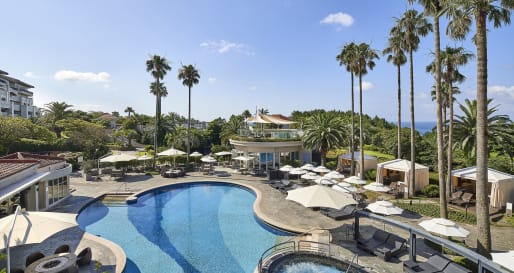Day Tour of Jeju Island
Your driver will meet you will meet you in the hotel lobby at 09:00am to start the tour of Jeju Island. This tour will take in Seongsan Ilchulbong Peak, Seopjikoji, Seongeup Folk Village and Seogwipo Maeil Olle Market.

Area
Jeju
Type
Community & Culture
Food & Drink
Wildlife & Nature
Grade
Standard
Who
Adults
Teens
Difficulty
Moderate
Duration
Full Day
Half Day
Seongsan Ilchulbong Tuff Cone rose 180 meters above sea level due to a magma flow under the sea over 5,000 years ago. It was originally a separate island, but a build up of sand and soil has connected it to the main island. A large crater, formed by the hot lava mixing with cold ocean water, is located at the top of Seongsan Ilchulbong Tuff Cone. The crater is about 600 meters in diameter and 90 meters deep. It has been featured in films, and was originally used for agriculture, but has now been given over to a field of silver grass. From the summit, visitors can see Udo Island, as well as take in the magnificent sunrise. The tuff cone area was designated as a natural reserve on July 19, 2000.
Staying on the coast head on to Seopjikoji which gets its name from its shape, jutting out to sea, with 'koji' being the Jeju dialect for a cape. Located just south of Seongsan Ilchulbong Tuff Cone, the cape is a popular tourist attraction. The tuff cone along with a beautiful vista of the ocean and fields of canola flowers can easily be seen from the peak of Seopjikoji. On top of the hill stands a beacon fire station, reaching 4 meters in height with a diameter of 9 meters, built using volcanic rocks. Behind the beacon fire station is Bulgeunoreum Volcanic Cone, vibrant with red soil. The white lighthouse atop the cone stands out in contrast. Seopjikoji has been used as a filming site for many Korean movies and dramas.
Located at the foot of Halla Mountain on Jeju Island, Seongeup Folk Village is a small town that holds a vast is a small town that holds a vast amount of culture over a wide period of time from 1410 to 1914. Cultural properties in the folk village have been handed down from generation to generation and include residential houses, Confucian shrines, schools, ancient government offices, stone statues, large millstones (pulled by horses or ox), and stone monuments. Among the cultural gems of the folk village are intangible cultural assets such as folk and stone monuments. Among the cultural gems of the folk village are intangible cultural assets such as folk plays, native foods, local folk craftsmanship, and local dialect.
Finish up the day at the Seogwipo Maeil Olle Market is the largest market in Seogwipo. It is a traditional market that was formed in the early 1960s and is a mainstay in the Seogwipo economy. Starting from 2001, the market expanded its shopping center and now stretches over 620 metres in length.The interior of the market is designed in such a way that visitors can easily navigate through shops and vendors. For customers' ease, the market offers free delivery service as well as cultural programs and and outdoor performances.
Return to the hotel by 17:00
Recommended Hotels Nearby
A selection of luxury hotel options in the area, handpicked and recommended by our travel specialists.
Call us on 020 8682 5060 to start planning





